Introduction
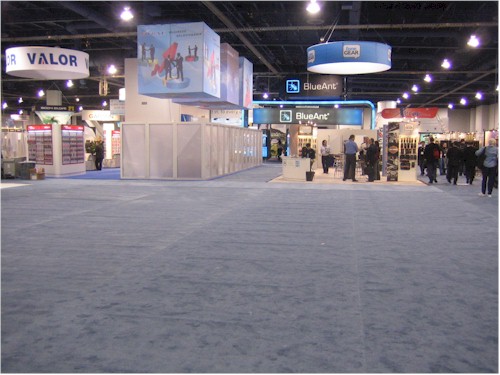
No, CES 2009 wasn’t really that empty and I didn’t see even one tumbleweed. But I’ll remember this one for the shortest cab and bus lines I have ever experienced at the show and an almost laid-back feel due to the lower attendance. But I’ll leave that navel-gazing to the pundits and instead provide a brain dump of my key take-aways.
First Atom-powered NASes
QNAP‘s CES release was short on details of its new "Intel-based iSCSI NAS Series". But my meeting with them revealed that their new six and four-bay TS-639 Pro and TS-439 Pro are both using Intel’s Atom.
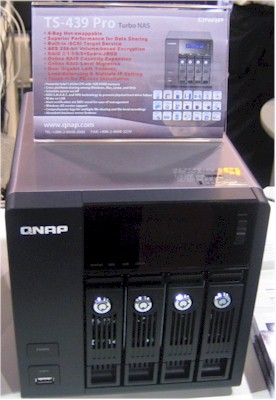
Atom-powered QNAP TS-439 Pro
MSRP for the 439 Pro is tentatively set at $799, which puts it $300 below its six-bay cousin the 639 Pro. And if an eight-bay solution is more what you need, the Core 2 Duo based TS-809 Pro will also be out soon. But it will set you back $1699.
QNAP will be sending review units as soon as they are ready. So if you’ve been wondering how commercial Atom-powered NASes will perform, you’ll know soon!
MoCA Finally Hitting Retail
The long road to being able to walk into Best Buy or click over to NewEgg and pick up a pair of MoCA adapters seems to be nearing an end. As previously reported, NETGEAR is going to ship its MCAB1001 MoCA Coax-Ethernet Adapter Kit to re- and e-tailer shelves shortly and I’m supposed to receive a pair next week. So I’ll finally be able to see if MoCA is a viable alternative for HD streaming for those of you haven’t had any luck with draft 11n or HomePlug AV.
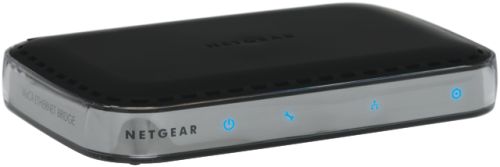
MCAB1001 MoCA Coax-Ethernet Adapter Kit
The twist in the story is that D-Link might be backing away from its CES announcement that its DXN-221 MoCA kit will be available this quarter. The D-Link rep that I met with said that the company would not be putting the kit on shelves and keeping it as a service-provider offering only. Maybe after the CES smoke clears this will change (and if it does, I’ll let you know). But for now, it looks like NETGEAR is going solo with retail MoCA.
Help On The Way for Draft 11n Wireless Streaming?
In meetings with Atheros, Broadcom, Marvell and Ralink, I delivered the message that draft 11n is failing to make the grade for reliable HD streaming. The culprits are high throughput variation and significantly reduced range in 5 GHz and I asked each company what their thoughts were. (I also gave the same assessment to the NETGEAR, D-Link and Cisco folks who I met with, but the conversations were generally shorter and less informative.)
In general, the chipmakers agreed with the assessment (or at least I think they did), but the get-well plans were varied. In some cases, it seemed like the wireless router makers need to be convinced of the need to move away from the throw-bandwidth-at-it and go for the highest throughput number approaches that they seem to favor.
But Broadcom seemed to offer the most concrete solutions. For shorter 5 GHz range, they are moving to put a 5 GHz power amp on-chip to boost transmit power by about 6 dB. This won’t raise it to maximum allowable levels, but 6 dB should make a noticeable improvement and, hey, we’ll take any improvement right now!
Broadcom also has spent the past year tweaking the Forward Error Correction technology they demonstrated last year so that it requires only a minor boost in throughput to provide significant protection against dropped packets. The demo I saw injected a 2% packet loss that caused minor, but constant pixelation in a streamed 10 Mbps MPEG2 1080p stream. But when the error correction was kicked in, the picture cleaned up within seconds.
Details were a little fuzzy on when the FEC technology would appear in Broadcom-based draft 11n routers. From what I understand, all of Broadcom’s existing draft 11n BB/MACs can be upgraded with the feature. But, of course, it’s up to the router makers to make it so. So we’ll have to keep an eye on firmware upgrades for Linksys / Cisco draft 11n routers.
One Stream, Two Stream , Three Stream, Why?
This CES saw D-Link and TRENDnet announce 450 Mbps draft 11n routers, but without firm ship dates. These routers use either Marvell or Ralink chipsets (the only two companies to announce 450 Mbps chipsets so far). These products need three MIMO streams to achieve the 450 Mbps maximum link (PHY) rates, which, in turn, requires at least 3X3 (3 transmit, 3 receive) radios on both ends of the connection. That’s gonna be a helluva trick to pull off in client devices, which tend to be either mini-PCIe cards built into notebooks or USB adapters for upgrade applications.
Getting decent antennas into USB adapters (which generally use 2×2 radios) is tough enough and getting in three will be even more difficult. And then there’s the little issue of power consumption and heat. Speed may not kill, but it sure generates heat and sucks power, two things that are not desirable in mobile devices.
I really don’t see the sense in 450 Mbps, given that manufacturers can’t even deliver consistent performance in the current crop of 270 / 300 Mbps "two stream" routers (see discussion above). It seems to me more something to generate buzz and bragging rights rather than a real benefit to consumers, especially since neither company announced matching adapters.
(I learned from my discussions that there is one three-stream client out right now— the Intel WiFi Link 5300 mini-PCIe. So if you happen to have that little guy in your notebook, then you should have a shot of getting a 450 Mbps link rate when these routers finally ship.)
On the other end of the draft 11n performance curve, the march to "single stream" (150 Mbps maximum link rate) draft 11n started by Atheros’ Align announcement a few months back continues. Ralink announced a single stream (1×1) chipset and so did Broadcom. But no one announced a 1×1 router at the show. This is probably because the Wi-Fi Alliance still hasn’t decided whether it will change its policy and certify single-stream APs / routers in addition to single stream "application-specific" devices.
So if single stream draft 11n routers do appear, why would you buy them, when you can pick up a Wi-Fi certified two stream router now for around $50? The explanations from the chipmakers (not the router manufacturers) was that the pitch will be higher speed than 802.11g for (about) the same price and better compatibility with draft 11n networks. (Since the single stream products "speak" 11n, they won’t cause throughput reduction when mixed in with two (or three) stream draft 11n products.) I say "about" the same price, because it’s likely the router makes will at least try to get a premium for the products when they first ship. But it’s expected that prices will quickly come down to g levels.
So what kind of throughput will you get with single-stream products? Well, the only data point I have is the demo I saw at Ralink‘s suite. They showed their 1×1 router reference design running a bi-directional IxChariot throughput script to their 1×1 client reference design. The IxChariot plot showed a nice steady 40 Mbps in each direction for a total of 80 Mbps of bi-directional throughput. I didn’t ask whether running only up or downlink would yield 80 Mbps; my guess is that it wouldn’t and you’d get only 40 Mbps.
Ralink also showed me a demo of their just-announced 3 stream chipset with two of their router reference designs, one of them configured as a client. They were running the high-performance IxChariot script with TCP/IP and no tweaks to IxChariots default settings. With the client and AP only 2 feet apart on a table, they were showing a simultaneous bidirectional throughput of 360 Mbps. They did say that with their silicon on both ends of the link they could kick in some special throughput-boosting optimizations. They also told me that when they run the Intel WiFiLink 5300 as the client, they get only around 270 Mbps; a speed they are working with Intel to improve.
I think it’s unlikely the average consumer will get 300+ Mbps from a three-stream router when they appear, however. Or maybe I should say I sure don’t expect that I’ll see that sort of performance. The highest speed I’ve ever seen from any draft 11n product is around 115 Mbps (running TCP/IP downlink, 40 MHz channel bandwidth), while manufacturers tell me that they frequently measure 150+ Mbps.
Finally, in other draft 802.11n news, I confirmed with Buffalo that they have no dual-band draft 11n routers in their reintroduced U.S. WLAN product line and don’t plan to have any. I forget the exact words, but the Buffalo marketing person I met with basically said that dual-band doesn’t sell enough to make it worth it.
Favorite Stuff
The question around campus at each CES is always "See anything good?" and my answer is usually "not really". But this year three things caught my eye and even brought a smile to my face.
Wireless HD (Wi-HD) looks like it finally may be the answer to people who are looking to ditch the cables between their high-def TVs and the assortment of boxes that pump content to it. Wi-HD can transmit uncompressed HD video (1080p 60 Hz) and control information at rates up to 4 Gbps in a 10 meter range using wireless signals in the 60 GHz band. It uses beam forming and steering to dynamically steer the signal around obstacles.
The demo of the LG plasma set in the Wireless HD Interoperability room was impressive in its simplicity. The wall display had the Wi-HD receiver built into the front panel below the screen, with the tuner and all other circuitry not directly related to the panel in a curvy black box that could have been mistaken for a DVD or Blu-ray player. As we walked around the room, and most of the time stood directly between the box and the display, a 1080p video played as if it were coming from a cabled source. Only when I put my hand right on the spot on the display where the Wi-HD receiver was, did the picture slightly break up.
When the Sibeam (the primary developer of the Wi-HD chipset) person running the demo shut off the LG box, the display briefly showed a "scanning for sources" message until it picked up the PS3 that was connected to a Abocom Wi-HD reference design bridge/hub and switched right over to it. The PS3 had a driving game (I think it was Gran Turismo) loaded and running and I "drove" a bit (mostly crashing into walls) to verify that there was no control lag through the Wi-HD connection.
The impressive part is that every demonstration I have seen of competing 5 GHZ UWB technology using compressed HD signals was always point to point, with the receiver and transmitter placed from 3 to 10 feet directly pointed at each other with no obstacles in between.
The two downsides to Wireless HD are that it really is an in-room only solution and it’s currently expensive. If I remember correctly, the retail pricing of the equivalent of the Abocom bridge would be $700 – $800. This should come down as volume builds on the product and as other chipmakers besides Sibeam come on line. (Broadcom has announced that it has joined the Wi-HD consortium).
At any rate, LG and Panasonic look locked and loaded and said they are releasing products in the first half of this year.
The second product that made me smile was Netgear‘s ITV2000 Internet TV Player. This is a deck o’ cards sized dedicated player that plays Internet (and downloaded) video with no computer needed. Think of the Roku Netflix player (which I have and thoroughly enjoy, except for the currently mostly crappy collection of stuff to watch) but with the ability to access a much wider range of Internet-based video.
The demo at the NETGEAR press conference looked pretty slick, so I spent some time getting a demo and playing with the product at NETGEAR’s booth. I learned that it’s not as magical as I thought, but it’s still pretty good. The first reality check is that even though it has an HDMI connector, the player’s output is limited to 480p, which is more than adequate for most web video. I find this kind of odd and probably need to poke at this some more later.
The other key limitation is that, like similar devices, it operates in a "walled garden", i.e. NETGEAR has to sign websites and other content providers up to be included on the device’s searchable content index. This is probably the main reason why the ITV2000 is slated to be relased in early summer, even though the hardware looks done now.
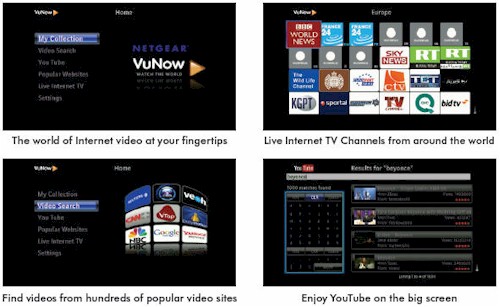
Netgear ITV2000 Internet TV Player screenshots
The user interface design is simple, attractive and responds quickly to commands from the included IR remote. The device will also play downloaded or ripped content from a USB-connected drive with DVD quality (assuming that the source is enconded with sufficient quality). From what I saw, if NETGEAR gets Netflix, maybe a pay per view movie service or two and all the major video sites like HULU and the major TV network sites into its tent by the summer launch, they should have a real hit on their hands. But if Roku wises up and does the same thing, NETGEAR could have a fight on its hands since the Roku player sells for $99 and can play HD content.
My last favorite product is HP’s new 2140 mini. If you’ve been following the netbook review series, you know I’m pretty picky about keyboard and mouse button layout. Well, I can say that the 2140’s 92% of full-size keyboard is absolutely the best keyboard that I have seen on a netbook, mini or whatever you want to call them. I swear the damn thing looks (and types like) full-sized, even though it isn’t.
It has generously-sized shift keys on both sides, and arrow keys moved down a row so that all the bottom row keys are the same size. The metal case gives it a very professional and polished look and fit and finish are first rate.
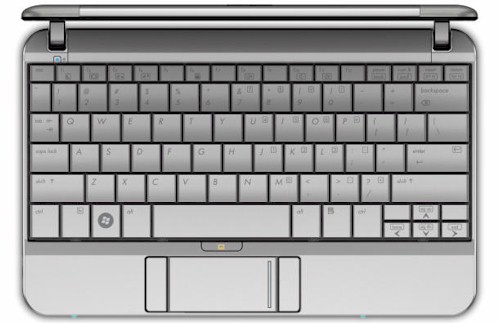
HP Mini 2140 Keyboard
The catch however (why is there always a catch) is that the touchpad has the side-of-touchpad mouse buttons like the Acer Aspire One. I can see why HP did this (the space below the keyboard is very narrow because they made the keys so large. But everything else on the 2140 is so impressive that I might have to forgive HP this design compromise and actually buy and keep one of these. Stay tuned!
